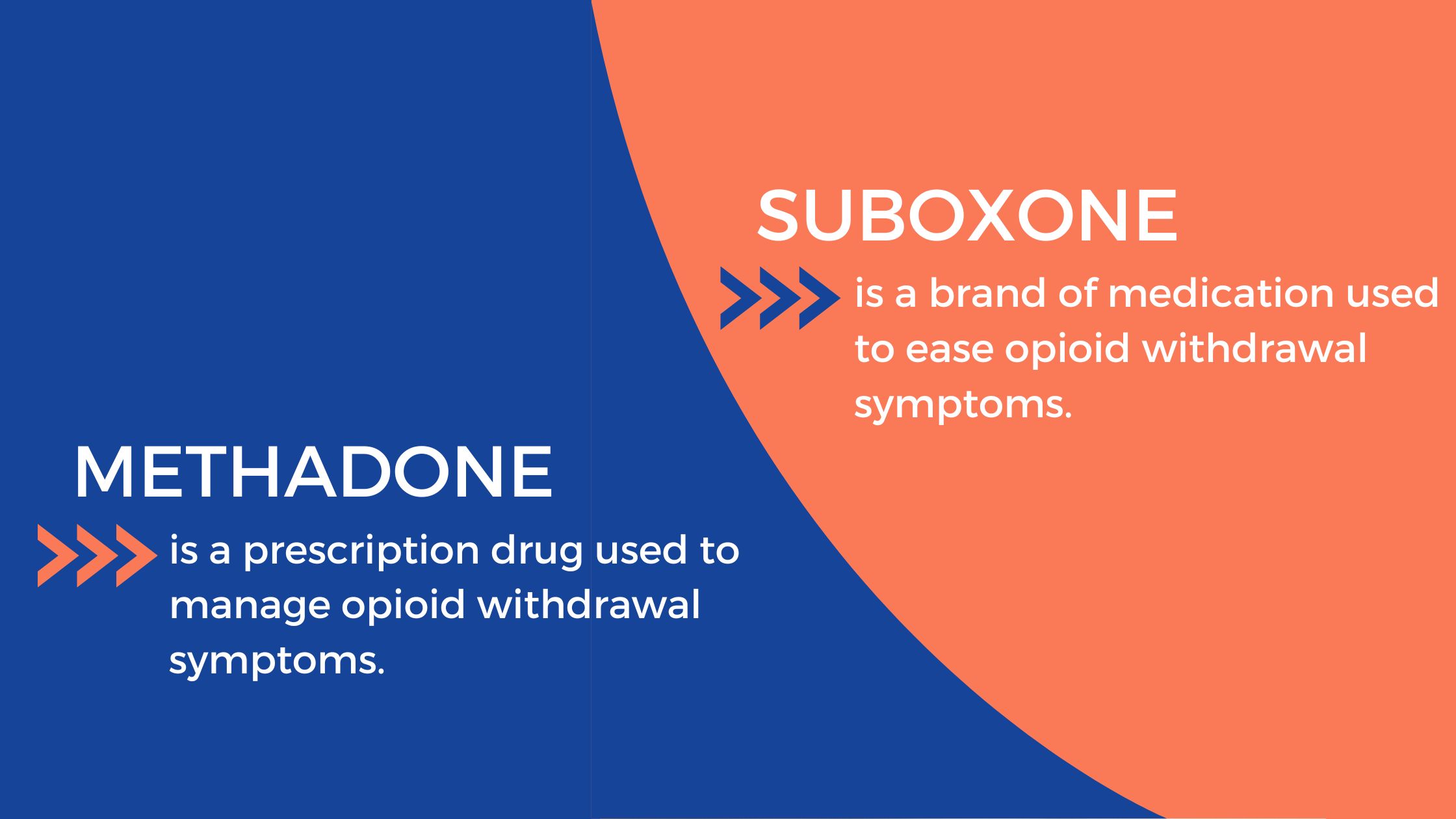Methadone vs. Suboxone – Treating Opioid Addiction


Written By
DreamLife RecoverySuboxone and methadone are prescription medications used to treat opioid addiction. Opioids are typically substances that act as opioid receptors to drive morphine-like effects. Medically, opioids are primarily used for pain relief, including anesthesia. Other common medical uses include diarrhea suppression, reversing opioid overdose, replacement therapy for opioid use disorders, and cough suppression.
Though useful for numerous medical purposes, opioids can also be habit-forming and addictive. Opioid addiction treatment takes place in recovery centers with professional medical supervision. Your doctor will use suboxone or methadone during treatment. Both drugs can help ease uncomfortable and life-threatening opioid addiction withdrawal symptoms.
What is Methadone?
Methadone is a prescription drug used to manage opioid withdrawal symptoms. The medication acts on the same brain parts as all other opioids but without causing a “high.” Methadone was invented during World War II due to a shortage of morphine (another powerful opioid painkiller).
Doctors in the US have been using methadone as a painkiller since 1947. A doctor often supervises the first phase of methadone administration, but the patient may be allowed to use the drug without supervision later on. Methadone prescriptions last at least 12 months.
What is Suboxone?
Suboxone is a brand of medication used to ease opioid withdrawal symptoms. The medication comprises two drugs, buprenorphine and naloxone. Suboxone acts less strongly on the same parts of the patient’s brain as methadone.
In the United States, addiction treatment professionals began prescribing suboxone for opioid recovery in 2002. The medication comes in three forms; films that melt under the tongue; pills; or 6-month implants under the skin of the arm.
Treatment with Methadone
When someone is under methadone medication for opioid addiction treatment, they can only get a prescription from a certified opioid addiction recovery program. These include methadone maintenance clinics. When starting treatment, you must visit one of these clinics and have a doctor supervise each dose.
Once your doctor is convinced that you are stable with methadone, they can allow you to use the medication at home but with regular visits to the clinic. Even when taking methadone at home, you will still have to get your supply from a certified opioid addiction center.
Treatment with Suboxone
You do not have to receive a suboxone prescription from a certified clinic. Your GP can give you a suboxone prescription. However, chances are that they will still monitor the first stages of treatment closely. Therefore, do not be surprised when your doctor requests that you visit their office for each dose during the early stages of treatment.
Even when allowed to take your suboxone medication at home, your doctor cannot give you more than just a few doses at a time. In the long haul, however, your healthcare provider will likely allow you to manage your suboxone treatment without much supervision.
Comparing the Benefits of Methadone and Suboxone
Both suboxone and methadone are effective addiction treatment drugs. However, they can both become addictive, especially after being used for a long time.


As for ease of use, suboxone is the best option because it may be started without the supervision of a doctor. Doctors can prescribe it within or without a comprehensive drug addiction treatment program. However, suboxone requires higher doses than methadone for effective treatment and is the least effective for avoiding opioid relapse.
Methadone is easier to use in flexible dosing plans. Take-home and flexible dosing can make it easier for patients to stick to their treatment plans and avoid opioid relapse.
Risks Associated with Both Medications
Methadone happens to be more addictive than suboxone. Withdrawal symptoms associated with methadone can significantly increase dependence on the drug. Some patients remain on methadone medication for life to stay away from opioids.
Suboxone is less addictive and does not cause intense “highs” like methadone. Cases of suboxone overdose are also less common compared to methadone overdose. However, unlike methadone, suboxone’s effects taper off after reaching a certain dosage amount, known as the ceiling effect. This ceiling effect plays a part in preventing prolonged use and overdose cases.
Nevertheless, suboxone overdose and addiction are still possible. Individuals new to opioids and those who mix medications are at a higher risk of suboxone overdose.
How the Side Effects Compare
Most drugs have potential side effects, which can happen during short- and long-term use. For both suboxone and methadone, potential side effects include:
- Shallow breathing
- Constipation
- Dizziness
- Nausea or vomiting
- Sexual problems
- Drowsiness
- Trouble concentrating
Comparing the Withdrawal Effects
Since both suboxone and methadone are opioids, they can easily cause addiction and withdrawal symptoms. Being a Schedule II drug, methadone is more addictive and thus poses a greater risk of misuse than suboxone.
Withdrawal symptoms associated with both medications vary in severity from one individual to another. Typically, methadone withdrawals can last 2 to 3 weeks, while suboxone withdrawal symptoms last one to several months.
Signs and symptoms of opioid withdrawal include, but are not limited to:
- Sweating
- Shaking
- Runny nose
- Feeling cold or hot
- Muscle aches and cramps
- Diarrhea
- Watery eyes
- Insomnia
- Goosebumps
Once you have started either methadone or suboxone treatment, you should never stop taking the medication on your own. If you do, you will expose yourself to life-threatening withdrawal symptoms. You will need to talk to a doctor first. This way, your doctor can gradually lower your dosage over time to reduce the likelihood of experiencing withdrawal symptoms.
Get Opioid Addiction Treatment Today
Medications like suboxone and methadone are just one part of a larger opioid addiction recovery program. They can help the patient stop misusing opioids initially. Long-term sobriety after completing treatment involves therapy, lifestyle changes, and family support.


At DreamLife Recovery, we offer comprehensive opioid addiction treatment programs in a recovery-friendly environment. Call us today at (855) 384-5808 to get in touch with board-certified treatment professionals and start your journey toward long-term sobriety.






